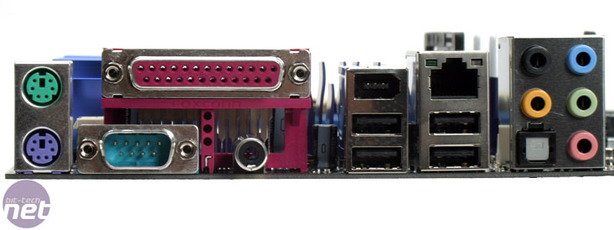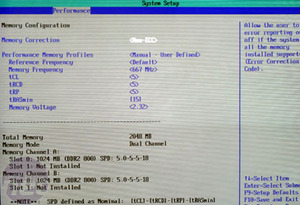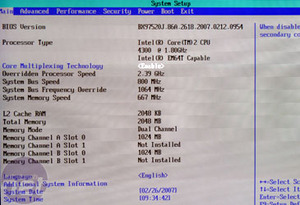Rear I/O
The rear I/O is an inoffensive standard affair; nothing is swapped around into unusual places or extra connectors included other than what you’d expect. It offers a mixture of old and new: serial, parallel and PS/2 ports, as well as four USB 2.0 ports, a 6-pin Firewire port and single Gigabit RJ45 Ethernet socket.Audio connectivity is provided from coaxial and optical S/PDIF out, as well as five 3.5mm analogue audio jacks providing 7.1 channels of surround sound and a microphone socket.
Everything is covered without being too excessive. Despite the fact that there's only a single Gigabit Ethernet, there are PCI slots available for additional connectivity. Legacy support is still provided for those who will likely identify with the brand and use the boards in scientific or research applications, which typically employ the generic ATX case and equipment that connects using RS232 or Parallel.

BIOS




Voltage Adjustments: CPU Voltage (1.2875V to 1.60V in 0.0025V increments); Front Side Bus Voltage (1.20V to 1.50V in 0.025V increments); MCH/ICH Voltage (1.50V to 1.70V in 0.025V increments); Memory Voltage (1.80V to 2.80V in 0.04V increments);
Frequency Adjustments: Front Side Bus (133MHz to 500MHz in 1MHz increments); Memory Frequency (400/533/667/800MHz); PCI-Express "burn in" (100MHz to 109.24 MHz in ~1.3MHz steps); PCI Latency Timer (32-248);
Memory Timings: tCAS (Column Address Strobe); tRAS (Row Address Strobe); tRP (Row Precharge); tRCD (Row to Column Delay);
Intel's BIOS is designed in a way which makes finding everything very easy. All the appropriate sub menus are clearly labelled and nothing is more than two sub menus deep.
Memory timings aren't at all comprehensive: there's no command rate adjustment or extra timings other than the standard four, and even then with the usual 2.3V put through our Corsair and OCZ we still couldn't attain stable 3-3-3-9 settings (Tim has had better luck with an earlier non-retail XBX2 board, though). The board was only capable of 3-3-3-15-24-2T stable, only a short stretch from our optimum 3-3-3-9-18-1T. Considering this is a second revision of a motherboard that has been available for at least 9 months, and it's Intel's own design, it's quite strange that the motherboard should be the limiting factor.
The overclocking options and voltage adjustments are considerably better catered for, with plenty of memory and front side bus voltage, as well as a reasonably high CPU limit. You'd expect it was more in Intel's interest to get as much out of stock speeds as possible, rather than offer quite comprehensive overclocking and voltage adjustments.

MSI MPG Velox 100R Chassis Review
October 14 2021 | 15:04







Want to comment? Please log in.